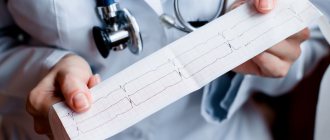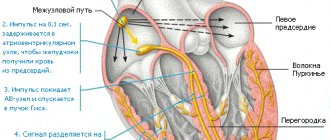Cardiology (from the Greek kardiā, “heart” and -logia, “science”) is a branch of internal medicine that deals not only with methods of diagnosing and treating disorders of the heart, but also the circulatory system as a whole. Although the cardiovascular system is closely related to the blood, cardiology is relatively unrelated to hematology and its diseases. Some obvious exceptions that affect cardiac function would be blood tests - electrolyte imbalances, troponin abnormalities, anemia and hypovolemic shock, and coagulopathies - pathological conditions associated with disorders of the blood clotting system. This branch of medicine becomes more and more relevant every year, because the number of cardiovascular diseases is constantly growing and they are the very first cause of death throughout the world.
Doctors who work in this field of medicine are called cardiologists. Because it is a fairly complex field in medicine and people usually spend a lot of time in it, working with other medical professionals, but the specifics of their day-to-day responsibilities may vary depending on the choices they have made when it comes to specialization. All cardiologists are clinical cardiologists who focus on the diagnosis, use of medications and prevention of cardiovascular disease. Some clinical cardiologists specialize in pediatric cardiology, which means they diagnose and treat heart problems in children. When clinical cardiologists treat only adult patients, they specialize in adult cardiology. Surgical aspects are not included in cardiology and belong to the field of cardiothoracic or cardiac surgery. For example, coronary artery bypass surgery or valve replacement. These are surgical procedures that are performed by surgeons, not cardiologists. However, the placement of stents and pacemakers is controlled, and in many countries even carried out by cardiologists themselves.
Main responsibilities
Like any medical specialist, the main task of a cardiologist is to care for patients, maintain their health and improve their quality of life. However, while general practitioners may see people with a variety of conditions and diseases, a cardiologist usually only deals with things related to the heart.
Content:
- Main responsibilities
- Reasons for mandatory visits to a cardiologist
- Preventive medicine
- Methods for diagnosing and preventing cardiovascular diseases
- Treatment of patients
This does not mean that there is no diversity here. There are many different things that lead to problems with the heart not working properly, from birth defects to damage caused by accident or illness. Therefore, it is a job that requires a lot of training, practice and constant attention to detail.
What does a cardiologist treat?
Much of the emphasis is on improving survival rates and quality of life after heart attacks, heart failure, or heart rhythm disorders, but cardiologists are also concerned with understanding disease processes and their prevention.
Cardiology doctors most often encounter the following pathologies, such as:
- ischemic heart lesions;
- defects (acquired over the years or discovered at birth);
- angina (chest pain caused by narrowing of the coronary arteries);
- arrhythmias, such as atrial fibrillation (irregular heartbeat);
- cardiomyopathy (heart muscle disease) with heart failure;
- coronary artery thrombosis or myocardial infarction (heart attack), often associated with hypertension and high cholesterol;
- arterial diseases (atherosclerosis, arteritis) and aortic aneurysm;
- damage to the heart muscles that occur against the background of inflammation of different areas (carditis);
- thrombosis and thrombophlebitis.
Doctors also treat patients who have suffered acute conditions, such as myocardial infarction or others. They help make decisions about cardiac surgery, angioplasty and stenting.
Major heart diseases
The uninterrupted operation of the main muscle pump is a necessary condition for the normal functioning of the body.
Impaired functioning of the heart can be caused by damage to the membranes of the organ, valve apparatus and blood vessels.
Ischemic lesions
The reason for such phenomena is a reduction in blood flow through the coronary arteries to the heart muscle. With high work intensity, this immediately affects her condition.
In most cases, ischemic conditions are a consequence of damage to the arterial walls by atherosclerosis. The lumen of the vessels narrows due to the compaction of the walls and the formation of thickenings on them. Most often this occurs in the coronary arteries, aorta and cerebral vessels.
The basis of ischemic pathologies is an imbalance between the needs of the heart muscle for the necessary substances and the possibility of their delivery through the arteries.
Ischemic damage can be presented in different forms, differing in symptoms and prognosis.
to contents ^
Angina pectoris
One of the most common manifestations of cardiac ischemia is as follows:
- Intense paroxysmal pain behind the sternum. It often radiates to the left arm and shoulder, and sometimes to the back and shoulder blade, less often to the abdominal area. Appears suddenly and lasts no more than a quarter of an hour; it is relieved with nitroglycerin.
- Heart rhythm disturbances. It is possible to both increase and decrease the frequency of contractions.
- Changes in blood pressure indicators (usually upward);
- Shortness of breath, feeling of restlessness, pale skin, cold sweat.
- Body temperature does not increase.
Mentally unbalanced, emotional people exposed to frequent stress are more susceptible to attacks of angina.
to contents ^
Myocardial infarction
One of the most dangerous forms of ischemic heart damage, in which, due to a sudden interruption of the blood supply to the heart, necrosis (necrosis) of the heart muscle occurs. The muscle tissue in this area dies, and connective tissue forms at the site of damage.
This condition is often preceded by a pre-infarction period, characterized by frequent attacks of angina. It lasts from several hours to weeks.
Disruption of the blood supply to the heart muscle for more than a quarter of an hour leads to irreversible changes in it.
Characteristic manifestations of the disease:
- Acute (according to patients' definition - dagger-like) pain in the chest, which does not stop after taking nitroglycerin. It can radiate to the left shoulder, teeth, ear, collarbone, lower jaw, and the area between the shoulder blades. The duration of an attack of pain can reach several hours.
- Anxiety, fear of death.
- Severe pallor and bluishness of the skin, cold sweat.
- Temperature increase.
In medical practice, 5 forms of atypical development of myocardial infarction have been noted, in which there is a risk of misdiagnosis.
- Abdominal form. According to WHO, it accounts for more than a third of all atypical cases of the disease. In the initial stage, the patient notes symptoms of an eating disorder: nausea, vomiting, belching, heartburn, bloating. Pain occurs not only in the heart, but in the epigastric region.
- Asthmatic form. The patient begins to choke, tries to take a sitting position, and develops a cough with foamy pink sputum. There is pallor in the area of the nasolabial triangle, hands and ears. Develops mainly in old age.
- Cerebral form. The course of the disease is similar to a stroke. There is speech impairment, nausea, spots before the eyes, weakness in the limbs, and possible fainting.
- The arrhythmic form is manifested by disturbances in heart rhythm, tinnitus, and dizziness. No pain is observed.
- Asymptomatic form of myocardial infarction. Diagnosed only in 1% of cases. Symptoms: severe weakness, dizziness, cold sweat. There is no pain.
Atypical variants of the disease are difficult to diagnose, so treatment is often delayed, which poses a danger to the patient’s life. In such cases, it is important to get an electrocardiogram as quickly as possible.
Myocardial infarction requires emergency hospitalization. If urgent assistance is not provided, the risk of death is high.
The result of ischemic heart damage is often cardiosclerosis - the growth of connective tissue in the myocardium, its replacement of muscle fibers and gradual deformation of the valves.
The main causes, symptoms and features of myocardial infarction are described in this video:
to contents ^
Inflammatory diseases of the membranes of the heart
These pathologies can be independent diseases or complications of other ailments.
- Pericarditis is damage to the pericardial sac. Manifested by shortness of breath, chest pain (increased with a deep breath, not relieved by nitroglycerin), rapid heartbeat, cough without the presence of sputum, swelling of the lateral jugular veins, and general weakness. Body temperature rises.
- Myocarditis is an inflammatory lesion of the heart muscle. Develops in acute or chronic form. It manifests itself as shortness of breath, a feeling of lack of air, pain in the heart, arrhythmia, and swelling of the veins.
- Endocarditis is inflammation of the inner lining of the heart. Very rarely it is an independent disease, forming as a result of other ailments. Rheumatic endocarditis is especially insidious, as it is asymptomatic for a long time. It occurs due to the development of rheumatism - inflammation of the connective tissue. Characteristic signs are a noticeable expansion of the last phalanges of the fingers and the formation of convex nail plates (tympanic fingers). With such a lesion, valve defects quickly develop.
The development of inflammatory heart diseases can be prevented through timely and correct treatment of infectious and viral diseases, strengthening the immune system, eating a balanced diet and giving up bad habits.
to contents ^
Heart valve pathologies
The heart valves determine the direction of blood flow, which is very important for the proper distribution of blood. Disruption of the rhythmic functioning of the valve apparatus, incomplete closing or opening of the valves can lead to serious cardiac pathologies.
- Valve prolapse. The reason is a pathology of connective tissue, leading to incomplete closure of the valve. As a result, there is a reverse outflow of blood. There are primary prolapse (congenital) and secondary (formed due to chest injury, as a consequence of rheumatism or myocardial infarction).
- Valve stenosis, characterized by narrowing of the valve opening. In most cases, the cause of the pathology is rheumatic endocarditis.
- Insufficiency of the valve apparatus is another consequence of endocarditis. The valve does not close completely.
Pathologies of the valve apparatus lead to the fact that the heart works under great overload. The heart muscle increases in size, but still pushes out an insufficient amount of blood. The blood supply to organs and tissues is disrupted.
to contents ^
Diagnosis of heart disease
If the disease of the most tireless organ is not detected in a timely manner, it can lead to death. Carrying out the necessary diagnostics if you suspect a heart disease is a vitally important issue.
- An initial examination of the patient, during which the doctor assesses the general condition, listens to complaints, measures pulse and blood pressure, taps the chest and listens to it with a stethoscope.
- Laboratory tests of blood and urine.
- Instrumental examination methods: electrocardiographic and x-ray examination, magnetic resonance and positron emission tomography, ultrasound, cardiac catheterization.
Based on the results obtained, the doctor makes a diagnosis and develops a treatment regimen.
to contents ^
Reasons for mandatory visits to a cardiologist
In almost all highly developed countries, consultations with a cardiologist are included in mandatory routine examinations. If you ignore this doctor, it can end very badly for the sick patient. All people understand and know about this, but still the majority constantly postpone or ignore visiting a doctor, knowing that they have heart problems. Cardiologists around the world have come to the conclusion that if every person consciously and seriously took their health, they could save up to 200,000 human lives every year.
Below are the most common complaints that should definitely lead you to a cardiologist:
- Pain in the heart area. They have a different character and can be pressing, aching, squeezing, burning, tearing, and can radiate to the lower jaw, upper limbs, and shoulder blades. This is the most common symptom in humans, which requires a thorough examination and diagnosis, since it leads to a number of serious diseases. It can even lead to death.
- The appearance of shortness of breath and a feeling of lack of air at rest or with little physical activity.
- Loss of consciousness for no particular reason or a state of fainting.
- Changes in heart rate or a feeling of irregular heartbeat. This usually leads to a general deterioration in the person's condition.
- Constantly recurring headaches, dizziness, decreased performance and general weakness.
- A sharp increase in body weight.
Risk factors are conditions or habits that make a person more likely to develop a disease. They may also increase the chances of an existing condition getting worse. Important risk factors for heart disease that the doctor and the patient himself can control are the following reasons.
High blood pressure
If your blood pressure is above 139/90 mmHg, then you should definitely consult a doctor. It causes excess pressure on the walls of blood vessels and leads to disruption of the normal functioning of many organs and, in general, leads to damage to blood vessels. If the pressure is not controlled by the correct lifestyle or medications, this leads to pathologies such as heart attack or stroke, the formation of an aneurysm, narrowing of blood vessels in the kidneys and their weakening, metabolic syndrome, impaired concentration, memory and attention, rupture of the eye vessels.
High total cholesterol
Total cholesterol is the sum of all cholesterol found in the blood. This can be said to be the main indicator of fat metabolism in the body. It plays an important role in the diagnosis of atherosclerosis and in determining the risk of coronary heart disease. Accordingly, the higher the cholesterol level, the higher the risk of heart disease. And if the readings are above 5.2 mmol/l, then the lipid profile needs to be examined in more detail to prevent possible health problems.
Diabetes and physical activity
If you are diagnosed with this condition, you are at greater risk of developing cardiovascular disease. Physical activity is known to reduce this risk of developing type 2 diabetes and better protect your heart. One study found that walking at least two hours a week reduced the rate of premature death from cardiovascular disease by about 50%. People with diabetes are thought to have better control of their blood glucose levels, reducing its negative impact on vascular health.
Smoking
Smoking has been known to be linked to heart disease and cancer since the 1940s. Since then, tobacco has been an important risk factor for a variety of diseases that can be fatal. If you've smoked since childhood, your risk of heart disease is much higher than someone who started smoking as an adult. Smoking contributes to cardiovascular disease through a number of mechanisms. It damages the endothelium, increases fatty deposits in the arteries, increases blood clotting, increases cholesterol levels, namely low-density lipoprotein, reduces high-density lipoprotein and promotes coronary artery spasm. Nicotine, the addictive component of tobacco, speeds up your heart rate and increases your blood pressure. It is also known that women who smoke are at higher risk of heart attack than men. If you are a woman and smoke three to five cigarettes a day, you double your risk of heart attack. A man would need to smoke six to nine cigarettes a day to double his risk. Smoking is estimated to increase the risk of stroke, coronary heart disease and impotence by 100%, and increases the risk of death from undiagnosed coronary heart disease by 300%.
Obesity or overweight
You can tell if you are obese by your waist size, waist-to-hip ratio, and the relationship between your height and weight. The latter is known to everyone as body mass index (BMI). It's not a perfect way to test your cardiovascular risk, but as your BMI increases, so does your risk of heart disease and stroke. Indeed, there are currently 400 million obese and one billion overweight adults worldwide. There are also rising rates of childhood obesity. Globally, an estimated 17.6 million children under five years of age are overweight. How does fat affect heart function? Intra-abdominal fat affects your blood pressure, blood lipid levels and interferes with the effective use of insulin, which later causes diabetes. Statistics show that 58% of diabetes and 21% of coronary heart disease are attributed to elevated BMI in people over 21 years of age.
Poor nutrition
The role of diet is critical in the development and prevention of cardiovascular disease. Diet is one of the key factors you can change, which will affect all other risk factors. A diet high in saturated fat increases the risk of heart disease and stroke. It is estimated to cause about 31% of coronary heart disease and 11% of strokes worldwide. In comparison, a diet low in saturated fat but high in fresh fruits and vegetables reduces the risk of heart problems by 73%.
Some risk factors, such as age, ethnicity or a family history of heart disease, cannot be changed. For women, age becomes a risk factor at 55 years. After menopause, women are more prone to cardiovascular disease, in part because their estrogen levels drop.
A family history of early heart disease is a risk factor that cannot be changed. If your father or brother had a heart attack before age 55, or if your mother or sister had one before age 65, you are more likely to have problems with heart disease.
You need to make lifestyle changes gradually. But making them is very important. Other women may wonder: If I only have one risk factor for heart disease—say, I'm overweight or have high blood cholesterol—am I “safer”? Absolutely not. Each risk factor significantly increases your chances of developing heart disease. But having more than one risk factor is especially serious because these factors tend to "cheat" and worsen each other's effects. Thus, every woman needs to take her lifestyle seriously.
Preventive medicine
Because many heart problems are chronic, long-term conditions, a cardiologist focuses on preventive medicine to neutralize and stop any progression of heart disease. Cardiologists perform a physical examination and interview a patient to assess their current health and predict any potential problems. In addition to prescribing medications, a cardiologist can also provide recommendations on proper diet, exercise, and lifestyle to improve heart health and proper functioning.
Methods for diagnosing and preventing cardiovascular diseases
An echocardiogram (ECG) is the main diagnostic tool used by a cardiologist to determine the health of a patient's heart. Echocardiography uses standard 2D, 3D, and Doppler ultrasounds to create images of the heart. It has become routinely used in the diagnosis, treatment and monitoring of patients with any suspected or known heart disease. This test can provide a wealth of useful information, including the size and shape of the heart (a quantification of the size of the inner chamber), capacity, and the location and extent of tissue damage. An echocardiogram can also give doctors other estimates of heart function, such as estimates of cardiac output, ejection fraction, and diastolic function (how well the heart relaxes). Echocardiography can help detect cardiomyopathies such as hypertrophic cardiomyopathy, dilated cardiomyopathy, and many others. The use of stress echocardiography can also help determine whether chest pain or related symptoms are related to heart disease. The greatest advantage for echocardiography is that it is non-invasive and has no risks or side effects on the body.
An electrocardiogram (ECG) records the electrical activity of the heart. That is, heart rhythms while a person performs exercise or records their regular activity at rest. This study helps determine the frequency and irregularities of the heart rhythm, if any. So-called cardiac arrhythmias. An ECG also determines whether there are any disturbances in the blood supply to the heart muscle.
Best materials of the month
- Coronaviruses: SARS-CoV-2 (COVID-19)
- Antibiotics for the prevention and treatment of COVID-19: how effective are they?
- The most common "office" diseases
- Does vodka kill coronavirus?
- How to stay alive on our roads?
24-hour blood pressure monitoring. Using this study, a cardiologist can evaluate changes in blood pressure throughout the day and see at what time of day it is high or low, and what this may be related to.
Holter monitoring evaluates heart function over a long period of time (even up to 3 days). Electrodes are placed on the patient's chest; they are attached to a so-called holter, which the person wears on his belt while changes in the heart are recorded. The doctor can then analyze rhythm disturbances in more detail and determine myocardial ischemia by analyzing the results of the study.
Stress test or treadmill test. It shows changes in heart rate during rest and exercise. The study is a cardiogram that is performed on the patient on the treadmill and after it. This makes it possible to see how the patient reacts to physical activity and how his cardiac system reacts.
How the heart works
The most tireless organ is located in the center of the chest, with most of it on the left side of the body.
The heart is housed in a sac around the heart called the pericardium. This dense sac keeps the organ in a stable position, preventing it from shifting and deforming under stress.
The walls of the heart are formed by three layers:
- The epicardium is the outer serous membrane.
- The myocardium is the middle layer that provides muscle contractions of the organ.
- Endocardium is a thin membrane lining the inside of the heart cavities.
The heart has four elastic valves. These kind of flaps prevent blood from moving in the wrong direction.
The tireless muscular organ is formed by two atria and two ventricles. Each of these chambers has a special role in the blood circulation process.
to contents ^
Treatment of patients
Once the cardiologist knows what the patient's diagnosis is, he must decide which treatment option is best. He may need to refer the patient to cardiovascular surgery for surgery, such as valve replacement. Or he may decide that the patient's condition is best treated with medication. Regular examination is required from time to time.
Therefore, we can conclude that a cardiologist is one of the most important medical professions. Because he is the one who is involved in the diagnosis, treatment and prevention of cardiovascular diseases, which rank first in the world in terms of statistics of all health problems.
More fresh and relevant information about health on our Telegram channel. Subscribe: https://t.me/foodandhealthru
We will be grateful if you use the buttons:
Heart hurts: who to turn to for help
If alarming “heart” symptoms appear, you need to consult a cardiologist. Today, due to the growing number of cardiovascular pathologies, this medical specialization is one of the most in demand.
Consultation with a cardiologist is necessary not only when characteristic symptoms appear. The modern rhythm of life with its daily stressful situations, dietary errors and physical inactivity leads to the need for regular visits to this doctor after the age of 35.
Often heart problems arise as a result of inflammatory processes of a rheumatological nature; these problems are dealt with by a doctor specializing in cardiology and rheumatology.
Heart diseases are easier to prevent than to treat: many of them are fraught with irreversible consequences for the body. A healthy lifestyle and avoiding stressful situations will help with this. If the heart still makes itself felt with alarming symptoms, self-medication is unacceptable and can cost life, qualified medical assistance is needed.











